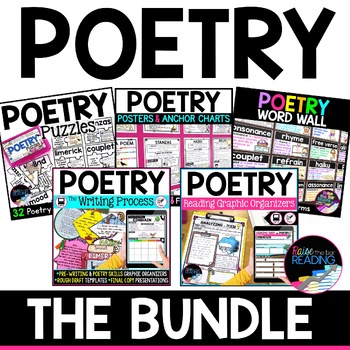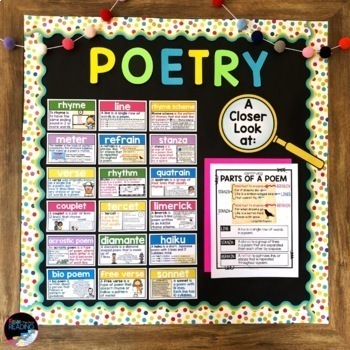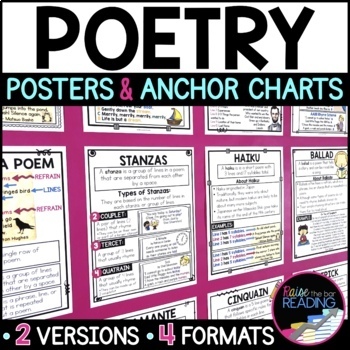Poetry Unit Bundle: Poetry Posters, Word Wall, Poetry Writing Graphic Organizers
- Zip
- Google Apps™

What educators are saying
Products in this Bundle (5)
Description
This Poetry Bundle is packed full of visuals and resources for having students dig deep into reading and writing poetry!
WHAT'S INCLUDED:
Create a beautiful visual word wall in your classroom to support your students in becoming strong poetry readers! Student-friendly definitions with supporting visuals are shown on each of the 35 poetry vocabulary terms.
This comes in 3 background color options, including a black background (as pictured), a multi-colored background (options for white font or black font), and an all-white background. They print 2/page on standard 8.5" by 11" paper.
Poetry Terms Included:
• poetry
• poem
• poet
• rhyme
• rhyme scheme
• stanza
• verse
• refrain
• accent/stress
• rhythm
• meter
• couplet
• tercet
• quatrain
• line
• alliteration
• consonance
• assonance
• sonnet
• haiku
• ballad
• limerick
• acrostic poem
• free verse
• diamante
• bio poem
• prose
• theme
• tone
• mood
2. Poetry Posters & Anchor Charts:
These poetry posters and interactive anchor charts are a must have for introducing and reinforcing tons of important poetry vocabulary and concepts. They dig deeper into each term in the word wall above. Printing flexibility allows for either reading poetry posters, interactive anchor charts, or mini (half page) posters/anchor charts for students' reading notebooks! A paperless, Google Slides™ version of all of the posters is also included for distance learning!
30 Poetry Posters/Anchor Charts Include:
• All About Poetry
• Rhyme
• Rhyme Scheme
• Parts of a Poem (Line, Stanza, Refrain)
• Accent/Stress
• Rhythm
• Meter
• Types of Stanzas (Couplet, Tercet, Quatrain)
• Alliteration
• Consonance & Assonance
• Haiku
• Sonnet
• Ballad
• Limerick
• Acrostic
• Free Verse
• Diamante
• Bio poem
• Shape poem
• Prose vs. Poetry
• Theme
• Mood & Tone
3. Poetry Writing Process Templates & Graphic Organizers:
Having students use the writing process for writing all types of poems is so helpful for growing poets! This resource covers everything students will need for writing their own poems from poetry graphic organizers in the prewriting stage to their own published copies. It includes graphic organizers and templates for 19 different types of poems, as well as elements of poetry. Teachers receive both a printable PDF version and a digital Google Slides™ version.
TYPES OF POETRY INCLUDED:
- Haiku
- Acrostic Poem
- Diamante
- Limerick
- Shape Poem
- Couplet
- Tercet
- Quatrain
- “I Am” Poem
- Quintain
- Cinquain
- Bio Poem
- Ballad
- Free Verse
- Sonnet
- Ode
- ABAB Rhyme Scheme
- AABB Rhyme Scheme
- ABCB Rhyme Scheme
WHAT’S INCLUDED for EACH TYPE OF POETRY:
1. Prewriting Graphic Organizers (2 Options):
Option 1: This option includes information about the type of poem, elements of the poem, and an example of this type of poem. There is a smaller space for brainstorming in this option.
Option 2: Does not included information about the type of poem. The entire page is for brainstorming for their poem
2. Rough Draft Templates: Each type of poem comes with a rough draft that clearly shows the structure of each poem. It also has an editing and revising checklist at the bottom specific to each type of poem.
3. Published Copy Templates (2 Options):
Option 1: Clean, basic final copy paper specific for each poem’s structure
Option 2: Visually specific for each poem (i.e. handheld mirror for an “I am” poem, a scroll for a sonnet, etc.)- perfect for a bulletin board display!
ALSO INCLUDED:
ELEMENTS OF POETRY GRAPHIC ORGANIZERS:
- “Brain Dump”
- Rhyme
- Figurative Language
- Sensory Details
- Mood
- Tone
- Word Choice
- Self-Assessment
A “Book of Poems” and “Poetry Journal” Cover is also included (optional).
These puzzles are a fun, interactive poetry activity that are great to use as part of a reading center, in guided reading groups, for poetry month, or as an early finisher activity. These 32 poetry terms, student-friendly definitions, and images can also be found as part of the poetry word wall.
Terms Included:
- poetry
- poet
- rhyme
- rhyme scheme
- stanzas
- line
- refrain
- accent/stress
- rhythm
- meter
- couplet
- tercet
- quatrain
- alliteration
- assonance
- consonance
- sonnet
- haiku
- ballad
- limerick
- acrostic poem
- free verse
- diamante
- bio poem
- tone
- mood
- theme
5. Reading Poetry Graphic Organizers:
Analyzing elements of poetry and comprehending poetry can be challenging for students. These poetry reading graphic organizers make it much easier for them to grasp these difficult skills. Included are both organizers that visually break down each skill individually, as well as organizers that require students to apply multiple skills at once. These graphic organizers are a must have for analyzing poetry in a way that is accessible to all of your learners! Teachers receive both a printable PDF version and a digital Google Slides™ version of all reading graphic organizers.
POETRY READING GRAPHIC ORGANIZERS INCLUDED:
- Breaking Down Figurative Language
- Identifying Types of Figurative Language
- Author’s Craft (2 Options)
- Elements of Poetry (2 Options)
- Identifying Rhyme Scheme (2 Options)
- Finding the Mood (2 Options)
- Finding the Tone (2 Options)
- Finding the Mood & Tone
- Sounds of Poetry: Alliteration, Consonance & Assonance
- Identifying the Type of Poem (2 Options)
- Theme
- Poet’s Point of View
- Comparing Point of View (Mine vs. the Poet)
- Breaking Down a Poem (2 Summary Options)
- Analyzing a Poem
- Text Evidence in Poetry (4 Options)
- Digging Deep into Poetry (2 Options)
- Poetry Feelings
- Visualizing Poetry
- Making Inferences from Poetry
- Asking Questions
- Making Poem Connections
- Analyzing Word Choice
- Close Reading (1 page for each of the 3 readings or 1 page only)
- Response to Poetry
- My Poetry Review





